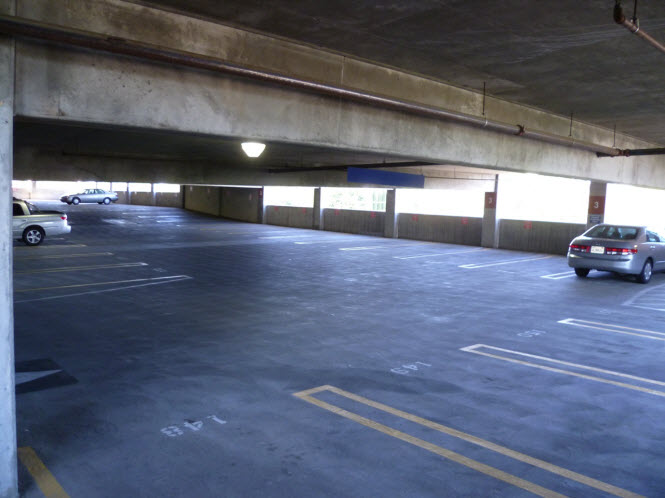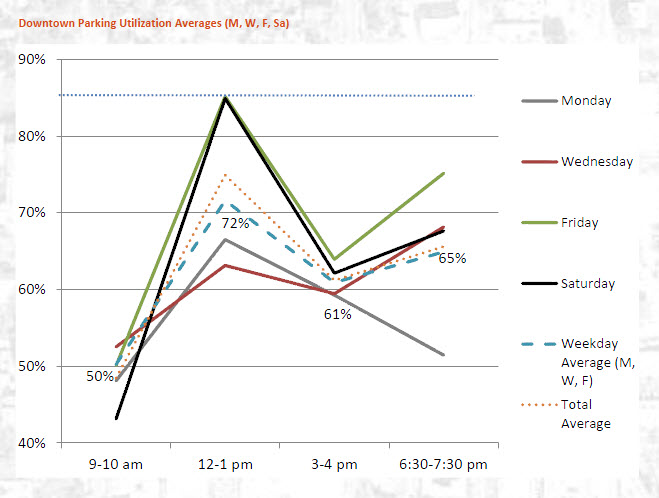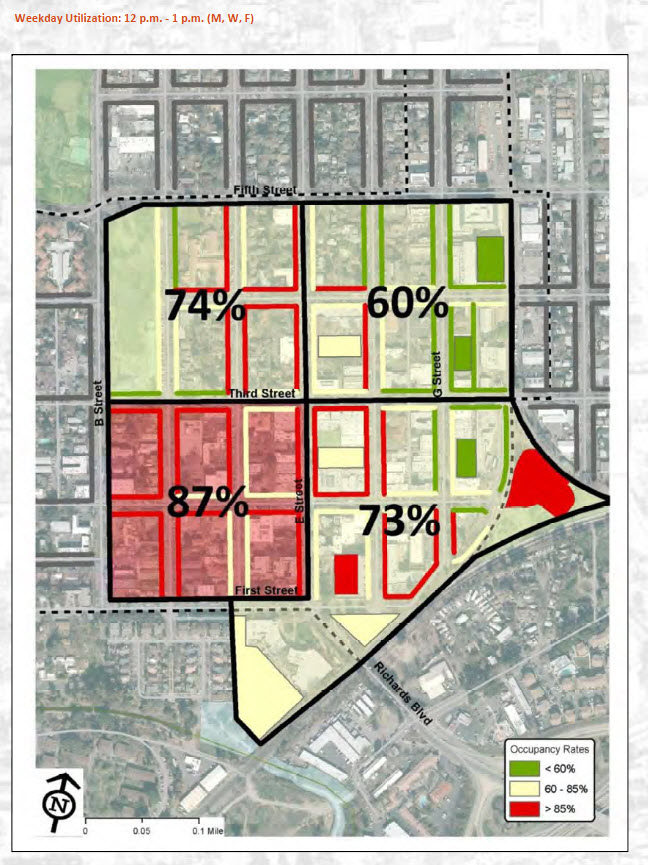 Sunday Monday Commentary: I want to be able to put my weight behind the parking proposal, but I can only put half of my weight behind it, because I do not believe it solves the entire parking problem.
Sunday Monday Commentary: I want to be able to put my weight behind the parking proposal, but I can only put half of my weight behind it, because I do not believe it solves the entire parking problem.
Some people will say that parking is the biggest problem we have in our downtown, but, as someone who works every day in the downtown, I don’t agree. The biggest problem that we have in the downtown is that the streets are poorly set up to accommodate multi-modal forms of transportation.
Try driving through downtown at a peak period either near the lunch hour or around five pm, and you have heavy traffic mixed with pedestrians mixed with bicyclists. You hit a four way stop and it’s difficult to navigate through. Bicyclists will run stop signs, and pedestrians will move across the street. It is a nightmare and there is no way to avoid it.
Compared to that difficulty, parking is a small issue. If you are willing to walk a few blocks, parking is rarely an issue.

The graphic above illustrates the issue. Even during the peak times, there is only 85% capacity that is 12-1 pm. There is a secondary peak time during dinner, but even that tops out at 75%.
Now according to the study, there are about 2100 parking spots available in the core. That means even at the worst times, there are still about 250 spots available and most of the time it is more like 700 spots available.


As the task force writes in their summary: “Generally speaking, the most coveted on-street parking can be very difficult to find on most days beginning with the lunch time peak and extending through the evening during the week. On-street parking and off-street parking lots and garages are underutilized.”
Some of this can and will be fixed relatively easily.
For example, “Parking literature and past studies conducted in Davis confirm downtown employees occupy prime downtown parking spaces. While it is not known what percentage of the downtown parking supply is occupied by commuters throughout the day, the desire to influence employee parking behavior dates back to the 1961 Core Area Plan. If employees can be shifted from prime on-street parking spaces into the underutilized parking supply, the downtown carrying capacity can increase, stimulating economic growth.”
Those types of solutions are low-hanging fruit – they are no brainers. They reflect the fact that we do not have a parking problem, we have a distribution problem. We allow long-term parking to utilize spaces that should be short-term spaces, while forcing commuters toward the periphery.
So too is fixing the Amtrak Parking Lot situation, which allows out-of-town drivers to park in the lot free of charge, making parking unavailable to other riders and users for much of the day.
And there is available parking at Fourth and G in the garage, which has 199 publicly available spots that “are not fully utilized” with occupancy rates ranging from 10 percent to 59 percent.
From our standpoint, therefore, any “solution” that fixes these low-hanging fruit, these particularities of the Davis parking scheme, is a good thing.
So we fully support the idea of increasing employee parking location options, particularly if it gets employees out of short-term commuter parking and into the garages. We fully support efforts to increase the permit fees and streamline the parking to an “X” permit. And we certainly support converting the Amtrak Lot to paid parking.
Restricting double-parking of delivery vehicles is a must – especially during peak hours, but it’s a problem at any time.
But to us, the biggest solution has to involve the biggest problem and, from our standpoint, the biggest problem is not parking itself but the interaction of multimodal transportation on streets designed largely for one mode – the automobile.
In the past, we have supported the idea of a large parking garage that funnels traffic away from the underpass and allows people to easily exit their vehicles at First Street and walk to their destination. Removing large amounts of vehicles from the equation may help.
At times we have pondered the idea of an automobile-free downtown; however, businesses would fret that this would harm their bottom line.
So why not create a tiered system. Right now, they are proposing paid parking in the southeast quadrant of downtown. This, of course, has led to some believing that this would harm business. Many other downtowns charge -sometimes a lot for parking, with little harmful impact.
The other alternative would be to make all street parking 30-minute parking. That solution allows the person who has to make a quick stop to get something from a store, or take out from a restaurant – to have the ability to park right out in of front of their destination, to go in and out and leave.
But, of course, if you want to do this, right now during peak times, it is difficult to navigate through pedestrian, bike and automobile traffic at intersection after intersection.
A lot of cities have created a tiered system – the shorter term your visit, the closer you can park to your destination. For a short trip, 30 minutes or less, you can park in close on the streets, two-hour parking a bit further out and long-term parking in the garages.
The bottom line for the parking task force report is they seem to tackle a lot of the low-hanging fruit that causes us the most problems. However, the longer-term question involves the ability of the city to look toward changing transportation patterns and to use parking to bolster those changes and help clean up the downtown once and for all.
—David M. Greenwald reporting






[quote]Restricting double-parking of delivery vehicles is a must – especially during peak hours, but it’s a problem at any time.[/quote]
How do you propose that businesses receive deliveries?
Move them to the periphery where there would be room?
Well…
first of all, businesses aren’t chess pieces. You don’t just “move them.” Location is important for retailers.
Second, every business, including restaurants, receives deliveries by truck. And those Sysco trucks are big, too.
Third, this post is several months old.
how about we re-invent historic alleys for deliveries? Seriously, deliveries are one reason I don’t see how we can eliminate car traffic. I was at a meeting recently when a member of the committee that studied the parking problems downtown told us we have a transportation problem not a parking problem. He said we need an electric trolley system that serves the town not the university. If we can provide public transportation we will solve the parking problem. Sorry, I didn’t get his name but I agree with him.
1. Parking and Congestion is a sign of a thriving metropolis. Consider the places that have lots of extra parking and no congestion: strip malls, shopping centers, Downtown Woodland. They are Dead Zones. Is this our ideal.
So, lets start by reframing the parking problem as an sign of success, not of failure.
2. Shoppers who an area looking for Parking is a source, by some measures of almost 25% of an area’s traffic. And it does discourage shopping if their are alternative–so the problem needs to be addressed.
3. The Ideas that shoppers won’t walk is not backed up by success of Regional malls. How do these stores manage employees taking prime spaces?
4. If taking up prime parking by employees is the problem, maybe the solution is in the hands of the downtown merchants: They can pay employees an extra $2 a day (10 minutes time at $12/hr wage- time for half a mile walk) to park and walk from a far out space. Consider that $2/day x 1 employees x 356 = $700/year per store to creates two parking spaces. Then lets consider that net parking spaces…either the land for them or cost of park spaces in elevated structures cost over $30,000 each–and the more parking spaces/structure you have the more spread out the stores to accommodate them..and the more likely people will want to repark their cars when they move from store to store.
5. Or to frame it another way: Why is the public on the hook to provide a parking-benefit to a stores employees? Employeers could provide Bikes to employees if the walking is too far–this is Davis, right?
6. Has anyone noted that H street near the coop –where 90% most homes have been turned into business–still require residential permit to park there? These are low hanging parking spaces that can be recaptured for employee parking.
7. Buying-out Curb Rights (for Parking) has long been discussed in by transportation engineers in academician (e.g. UCLA’s Prof Donald Shoup) who study parking. Residential streets around downtown are overly wide compared to current standard. And most residents don’t use their curb parking during the day. Might be beneficial for the city to buy out the “curb rights” of these neighbors to allow more street parking–especially for employees, in these neighborhoods. Lets give the $30,000/space to Davis residents instead of building or creating more parking-lot induced sprawl that will encourage people to re park when they visit two stores.
Parking and Congestion is a sign of a thriving metropolis.
Yes, also a sign of self-imposed congestion from decades of under-development and extreme downtown merchant protection.
Don – I have had even more than the average difficulty moving through downtown – on a bicycle – at 12:30 with delivery trucks double parked on both sides of the street. I rarely get takeout from downtown restaurants any more because of the hassle factor. To reverse the situation, why can’t I double park in a car while doing a pickup?
At the very least, double parking should be absolutely prohibited between 11:30 and 1:30 – deliveries can be made at other times of the day. Other cities do this successfully.
I don’t think there is either a parking or traffic problem downtown. I like it just the way it is. I drive downtown occasionally and it never takes more than a couple of minutes to find a place to park. The traffic is slow, but it always moves. I more often ride my bicycle and that’s even easier, both traffic-wise and parking.
That employees or business owners would park in the core area is inexplicable to me. It makes the downtown less accessible and wastes just as much time as parking more remotely and walking a ways what with having to go to your car and move it three or more times in a day. It’s stupid.